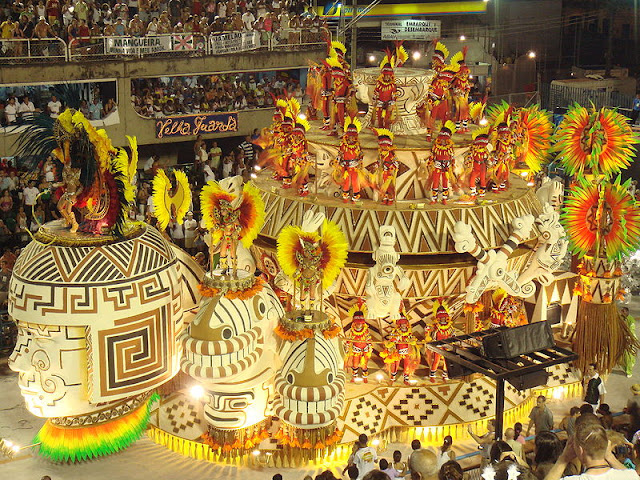The relative cheapness of food and rapidly growing market of tourist services make Ecuador an attractive country for tourism. In a charming, slightly elongated plain at an altitude of 2800 m, is located the capital of Ecuador - Quito - one of the most colorful cities in Latin America. It comprises many cultures and traditions. Most clearly seen in Architecture - Spain, Holland and even pre-Columbian architectural motifs create a wonderful mixture of the 2 eras. In modern buildings of the American Quarter adjoin the narrow streets of the Latin, with beautiful chapels, churches, monasteries, houses of stone and mud brick. Just need to visit the Independenc e Square, near the Presidential Palace, admire the monasteries of La Compagnia, San Francisco and San Diego, visit the Museum of Colonial Art, which contains the magnificent works of the masters of South America - picture Guyasamina Osvaldo Oswaldo Viteri and Olga Fish.


It is impossible not to visit the Natural History Museum and the Museum of Archaeology, where you make a fascinating journey into the past, see the collection of blood vessels, arrowheads from El Inga, dating from the 10th millennium BC, as well as the magnificent conical vessels - aribalos "period of Inca (1450 - 1534 years.). The art of the era preceding the Inca era, most pronounced in the figure of La Tolita (500 BC - 500 AD) and Valdivia - the oldest in America. Walk "Chiva Don Otto (" Chiva "- is the name of the old nation-wide public bus) - the sounds of folk music, you ride through the narrow streets of Lower City, try a hot drink of cinnamon - kanelazo, traditional sweets and snacks.
Walk to "Chiva" - a taste of night life of colonial Kito. Just 15 minutes away to the north of the capital is the equator, there is the Museum of Ethnography and Culture "middle world", the picturesque ruins of the Inca Rumicho and a fantastic view of the crater Pululaha. The most common routes: Quito - Guayaquil - Galapagos Islands and Quito - the neighborhood of the volcano Chimborazo, Nat. Park Sangay, Inca pyramids, mountain steppe highlands of the Andes, diving on the Pacific coast. Cuenca - cobbled streets of the city perfectly complemented by artfully cast vignettes balconies, traditional jewelry, handicrafts items confirm the ancient culture of the natives.
.jpg)
Magnificent cathedral, the convent buildings and museums will not leave you indifferent, as well as the city's landmarks - the river Tomebamba beautifully envelope of old houses. Not far from Cuenca is a wonderful place - El Kayasy - Country 200 lakes and lagoons, and a relic of an ancient culture - Ingapirca, traditional political and religious center Kanyaris, later turned into a ceremonial Inca castle and fortification. In the north-east of the town are picturesque villages and Gualaseo Horteleg, known for its artists and artisans. Here you can purchase artfully constructed "Panama", traditional textiles and ceramics. One of the most beautiful places in Ecuador, the area around the volcano Chimborazo (altitude 6310 m). Here goes Expresso Metropolitan "- one of the highest railway in the world, which is laid past the cliffs of the mountains. The train moves at a speed of 50 - 60 km / h. and rises to the top of the mountain for 8 hours (by car is much faster). From the roof of the train, specially equipped for the journey, a wonderful view. At Indian small markets at Ecuador you will find a variety of goods and crafty artisan crafts, rightly considered the best in America. Some Indian markets are not like the others, Otavalo Indian market is quite different from the Indian market Sakuisili, Zumbahua or Cáñar.
Marvel at the variety you a variety of products with an indelible imprint of the oldest in the Americas culture. Ecuador owned by the world-famous Galapagos, Ecuador's main tourist attraction. Educated as a result of volcanic activity and reminding spray congealed lava in the ocean, the islands abound with amazing beaches softest sand, olive, white and black, creating a unique landscape. On some islands you will see the red mangroves and acacia, the other - cacti and tropical plants. Underwater a diverse, there are more than 400 kinds of various fish and plants most bizarre coloring. It is a paradise for divers - in the waters of the archipelago inhabited by sea lions, penguins, dolphins, sharks, whales, and many other representatives outlandish fauna. In fact, the archipelago reign iguanas and giant tortoises - the most ancient reptiles planet. The country has the most favorable conditions for the trip to the jungle. In the national park "Oriente", 2 reserves and eight protected areas, are equipped with hiking trails and parking. According to one of the tributaries of the Amazon, Napo River, you can make a memorable trip in a real Indian canoe or boat.




.jpg)














































